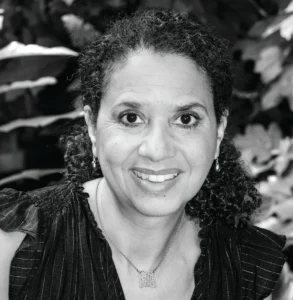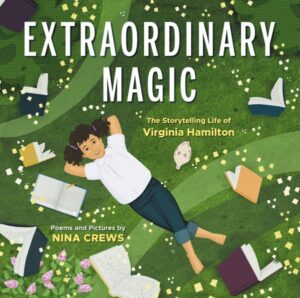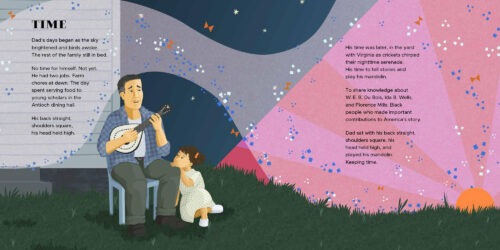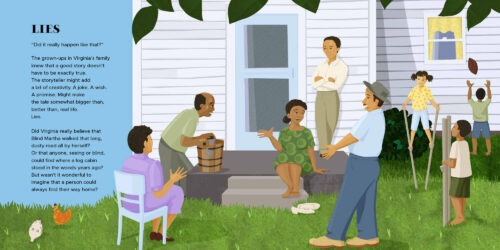Nina Crews on Virginia Hamilton: The Complete Interview
If you received your February edition of School Library Journal then you probably encountered the cover article dedicated to my interview with Nina Crews about her incipient picture book biography of Virginia Hamilton. Called Extraordinary Magic, the book is already out on bookstore and library shelves everywhere.
The article printed in SLJ was a truncated version of my full talk with Ms. Crews. Today. I am pleased to present to you the final unexpurgated version. Enjoy!!
One of the greatest writers of children’s books, Virginia Hamilton has been honored with everything from medals to book awards in her name. Yet until now she has never inspired her own picture book biography. EXTRAORDINARY MAGIC by Nina Crews, follows the trajectory of Ms. Hamilton’s life, discussing each aspect through poetry.
ADVERTISEMENT
ADVERTISEMENT
Betsy Bird: Nina! Hello! Thank you so much for talking with me today. For all that we live in a world of increasingly magnificent picture book biographies, I think it’s fair to say that your EXTRAORDINARY MAGIC is the very first to center Virginia Hamilton as its subject. What drew you to Virginia?

Nina Crews: I was interested in creating a biography of a Black woman creator and I wanted to tell the story of someone whose work would be of interest and accessible to young readers. I’d read and loved Virginia Hamilton’s books as a child. (Zeely and M.C. Higgins, the Great) Virginia Hamilton was one of the most celebrated children’s authors of her time, that no one had written about her in the picture book space made the idea even more attractive to me. I read some of Hamilton’s speeches and essays and found that she often spoke in depth and detail about her childhood and her family and how they connected to her writing. This convinced me that her story would resonate with young readers.
BB: Tell us a little bit about your research process. From what I can tell, you didn’t have a single source to draw from but used an array of different books, speeches, essays, anecdotes, etc. to put this book together. What was your process? How did you decide what to use, and how did you find your sources in the first place?
NC: When I began thinking about this project, I started by considering what was possible. Could I focus on her childhood, and how much information could I find? I began with Julie Rubini’s middle grade biography, Virginia Hamilton: America’s Storyteller, which devotes the first two chapters to her childhood. The bibliography of this book led me to Hamilton’s collected speeches, Virginia Hamilton: Speeches, Essays, and Conversations. My copy of the book is filled with post-its, bookmarks, and underlined passages. I found some stories that really stood out and themes began to emerge.

I am astounded by how much I need to know to write (or illustrate) nonfiction with any confidence. To write this book, I needed to understand the context of her experiences. The internet delivered big time. I found the Yellow Springs News’ online archives and learned more about that place and its history. It’s an interesting place – a haven of sorts for formerly enslaved people and the location of the very progressive Antioch College. I found a Bryan High School School yearbook which included photos of Hamilton, three of her siblings and at least one cousin. I discovered an article that her oldest sister, Nina, had written about her experiences as a student at Antioch. It wasn’t always information I could directly use in the book, but I loved finding it anyway.
I visited Yellow Springs in 2021, to get a sense of this place that she was so deeply attached to. While I was there, I went to the collections of Hamilton material at the Antioch College Library and the Greene County Community Library. Both had fat files of clippings about Virginia Hamilton and her family. There is a painting of her father Kenneth Hamilton on the Antioch College library wall! He was the dining room head waiter and trained many students in their dining hall work study jobs. I also reviewed the papers that Hamilton donated to the Library of Congress in Washington DC. There wasn’t much there that pertained to her childhood, but it was fascinating to see her manuscripts and notes.
BB: You had some primary sources to draw on as well. I see that you interviewed Virginia’s husband, fellow children’s author Arnold Adoff. Can you tell us a little bit about that meeting and what you learned?
ADVERTISEMENT
ADVERTISEMENT
NC: My conversation with Arnold Adoff was an absolute delight. I’d never met him (or Virginia) in person, but we’d been Facebook “friends” for a few years when I approached him. He was incredibly enthusiastic and generous with his time. When we spoke, I’d been working on the book for almost a year, but still hadn’t settled on an approach. I had some ideas about important themes I wanted to focus on and many questions about her childhood, family, and her hometown. Adoff was still living in the house that they’d built on the last acres of the Hamilton family farm. He was a terrific storyteller and we talked for over two hours. He confirmed some of my ideas, provided important family history and told me about their courtship and early years in New York City. We talked about shared connections in publishing. He talked about their commitment to diversity in children’s literature – the work she did, and he continued to do, to support emerging writers.

BB: Was there anything that surprised you about Virginia in the course of your research? Anything unexpected that you didn’t think you’d find?
NC: I honestly didn’t know what I’d find, but I found it all deeply interesting. I learned a bit about the history of Ohio and abolitionism. The Ohio River is just about an hour away by car and was a dividing line between slave and free states. Hamilton’s grandfather was just two years old when he was brought to Ohio by his mother to be raised by another family. Hamilton told different versions of her great-grandmother’s story over the years speculating that she may have gone further north to Canada or helped others down South escape enslavement. I learned that Coretta Scott King and her older sister, Edythe Scott Bagley, attended Antioch College and that Edythe knew Hamilton’s older sister, Nina. I also learned about the big role music played in Virginia Hamilton’s life. She spoke regularly about her father playing the mandolin. She sang and played the mandolin as well. While in college, Hamilton aspired to be a singer and would travel to New York City to perform in coffeehouses and jazz clubs. She and Arnold first met a jazz club, Charles Mingus was playing.
I found many surprises along the way. In Willie Bea and the Time the Martians Landed (which was inspired by her families’ reaction to the H.G. Wells “War of the Worlds” broadcast) the children walk around on stilts. Did Virginia Hamilton stilt walk as a child? Of course, she did! She told an interviewer that she and the other kids in the family stilted a lot, mentioning that it is an African tradition. I didn’t see a place for this is the text, but I show her on stilts in the illustration for LIES.
BB: Was there anything you thought you’d find in your research but didn’t? Or anything you wanted to include but couldn’t for lack of information?
NC: In many of her speeches, Hamilton spoke about the importance of social justice, Black history, and the ways in which her family had been denied fair treatment. These themes are also in her books. Her childhood was in the 1930’s and 1940’s, well before Federal civil rights legislation ending segregation. Public schools in Ohio had been integrated in the late nineteenth century. Protests successfully desegregated the movie theater in Yellow Springs in 1942. Other businesses like barber shops were desegregated in the 1960s. Hamilton participated in desegregation protests at Woolworths in New York City in the 1960’s. I was hoping to get a clearer picture of how she would have understood prejudice as a child. Would her father have shared reports from the Black press about civil rights protests or lynching? Would she have overheard the grownups talking about these things in hushed tones on a Sunday afternoon?

Extraordinary thanks to Nina for answering my questions today. You can find EXTRAORDINARY MAGIC OUT on booktore and library shelves everywhere. Find it, seek it, and enjoy it.
Filed under: Interviews
About Betsy Bird
Betsy Bird is currently the Collection Development Manager of the Evanston Public Library system and a former Materials Specialist for New York Public Library. She has served on Newbery, written for Horn Book, and has done other lovely little things that she'd love to tell you about but that she's sure you'd find more interesting to hear of in person. Her opinions are her own and do not reflect those of EPL, SLJ, or any of the other acronyms you might be able to name. Follow her on Twitter: @fuseeight.
ADVERTISEMENT
ADVERTISEMENT
SLJ Blog Network
2024 Books from Printz Winners
Unhappy Camper | This Week’s Comics
Fighting Public School Book Bans with the Civil Rights Act
ADVERTISEMENT







